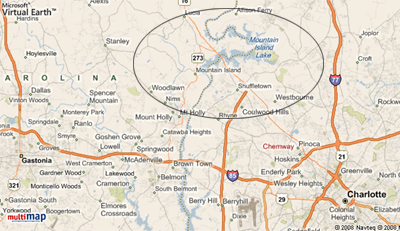
There is unrest among the neighbors of Mountain Island Lake. Newcomers want to halt efforts to increase regulation and fees related to recreation on the lake, while old-timers — many of whose families were living on its shores long before the Catawba River was dammed, in 1924, to create the lake — want to preserve what remains of the lake’s natural beauty and resources.
And while the debate goes on, hardly anyone is discussing the central role the river has played in history, and the impact those events have had on the nation, the state and the region.
Over the next few weeks, I will be publishing a series of essays on the history of Mountain Island Lake region going back to the original settlers of the region. The essays are intended to provide context about the lake’s past as we debate its future, which at the moment appears to be perilous.
First, for those not familiar with the current crisis, here is some background information:
In the past decade, sub-divisions have sprung up along the shore-line of Mountain Island Lake like fields of mushrooms. Now, many of these newly arrived “back-country settlers” are disturbed by new regulations and fees proposed by the Mountain Island Lake Marine Commission. It involves taxes. It involves restrictions. It will stifle their pursuit of recreational happiness.
The Mountain Island Lake Marine Commissionn was formed by a Joint Resolution of Gaston, Lincoln, and Mecklenburg County. The Marine Commission is instructed to preserve and protect Mountain Island Lake. Currently, the Marine Commission is sponsoring new Motor Vessel Managed Access Regulations which would place restrictions on the length of boats allowed on the lake, and new fees for permits to operate a boat on the lake.
For further information on the condition of Mountain Island Lake visit also Lake Norman Covekeepers, which is a part of Lake Norman Riverkeepers.
If you are against their proposal, go to Boaters against Motor Vessel Managed Access Regulations and sign the petition. As of May 25, 2010, there were 433 signatures.
In recent decades, thousands of homes have been built along the Mountain Island Lake’s twenty-seven mile shore line. The coves and the river are lined with homes and piers. The lake’s surface area is a mere 2,788 water-acres. No one is in favor more taxes. Who has an extra dime these days? Still, do you know that in 2008, the Catawba River was labeled the most endangered river in America?
I believe anyone who is fortunate enough to live on a window of land that would allow you to every day have the opportunity to watch twilight unfold in the western sky and to watch the morning mists that drift above the Lake. I believe you own Paradise. I only wish that I could live upon these shores. I understand your frustration. I have always rebelled against regulations and rules. I truly believe it has to do with the mysticism of Mountain Island Lake or, as we referred to this body of water, in my youth, the Catawba River.
According to the EPA, the Duke Energy owned coal-fired Riverbend Steam plant operates two of the 44 highest hazard coal ash ponds in the United States. The steam plant is located on the Riverbend peninsula which juts into the Catawba River like a thumb.
I read on one note written by a concerned home/boat owner in which he referred to the possibility of Mountain Island Lake becoming as regulated as Lake Lure, NC. Would that be bad? I wondered. Isn’t it important in this era of dwindling natural resources that we take note and preserve what we can? The Catawba River and Lake Lure existed before time and memory.
As noted, we’ll be looking at that history over the next few weeks, but here’s a brief overview:
Along the lake, all across the three county area, you will find large and small volcanic rocks. These volcanic rocks seem to grow like potatoes when the spring fields were plowed. The shoreline of Mountain Island Lake, the woodlands, forests, and shores of the Catawba River are littered with volcanic rocks. If you are fortunate and resolute, there are several very special rocks that bear proof that they were not alone. These rocks are as old as the eons, and they were used by Paleolithic Indians to grind nuts. For centuries and decades, grandmothers and daughters wore smooth bowls into these rocks.
The earliest inhabitants of the Catawba River and the land were the Catawba Indians who called themselves the “people of the river.” The forests were home to the wild beasts, panther, cougar, bear, buffalo and moose. The Catawba River was home to poisonous snakes, and all manner of fish and fowl. Even today, at dawn and at eventide, the raptors, eagles, hawks dive as swift as arrows shot from a bow, deep into the water spearing fish for supper.
The original German and Scots-Irish settlers began to cross the Catawba River into Carolina back-country around 1745 to 1750. Around the same time, Robert Alexander built the Red-House in Woodlawn (Mt. Holly), overlooking the Catawba River. Alexander was married to Martha Jack, the sister of Captain Jack who carried the Mecklenburg Declaration of Independence to Philadelphia.
In the early years, the Catawba River was the dividing line at the edge of the world between civilization and the wilderness. Beyond the shores of Mountain Island Lake lay the land of the Cherokee. At that time, Mountain Island Lake/Catawba River was the fartherest edge of civilization.
The settlers who came to the wilderness of the Catawba River came because they had been driven from the coastal cultures of civilization. They came to settle on land they owned. It was the first time peasants were allowed to own property. As plow people, the Ulstermen, the Scoti, and the Palatines were farmer-peasants. Because of their natural knowledge of the earth and the moon…they understood the treasures they had been given by Good King George. The back-country settlers spoke a universal language, the understanding of the rhythms of the seasons, and the names of the full-moons. For these farmers, day began at sunset.
Settlers were far and between, but there was a brave young German settlement along the creeks of the South Fork tributary of the Catawba River. It was known as the Warlick settlement and later it became known as Ramsour’s Mill.
In 1768, a new county was created out of old Mecklenburg west of the Catawba River and south of the Earl of Granville line. This new county was named Tryon in honor of the British Governor William Tryon. A decade later, the county was renamed to honor Major-General Benjamin Lincoln, of Rhode Island, and commander of the Southern Armies during the American Revolutionary War. Unfortunately for Gen. Lincoln, he is mostly forgotten today, because he led the Continental forces during their disastrous loss of Charleston to the British in 1780. Now most people assume, incorrectly, that the county was named after President Lincoln. Much later, in 1846, Gaston County was created from Lincoln County.
On October 7, 1780, our ancestors joined with the Over-Mountain Men at the Battle of Kings Mountain and turned the tide of the war in favor of the patriots. Among the heroes counted on this day were William Chronicle of Belmont and the militia of young men known as the South Fork Boys who grew up along the banks of the Catawba. The Battle of Kings Mountain turned the tide of the American Revolution and made victory at Yorktown, possible.
The Catawba River and its South Fork tributary were as important to the original settlers as an airport is to modern cities. The Catawba-Wateree runs to the sea providing a way for the settlers to ship their iron and cotton to the world.
For more than 150 years, my ancestors ferried the Catawba. The ferry was located near where the Rozzelles Ferry Bridge is built on NC Highway 16. For a bit of silver or gold, they would come for you to bring you home or take you away.
The Abernethy ferry is noted on an old and faded map drawn in 1768. It is told that James Abernethy and his sister, Jane, journeyed from Jamestown, Virginia, with their aged parents to the shores of the Catawba River. Here, their journey ended. At the end of an old Indian trail they established an inn and a ferry.
Their second-cousin, Jim Abernethy, traveled with them and in the years to come, Jane Abernethy married Cousin Jim. The Abernethys hailed originally from Perth, Scotland. These first Abernethys were Picts. The Picts were Celtic barbarians who once lived the highlands of Scotland. The Picts fought the Romans and the Saxons who stormed the British Isles. No one knows where the Picts began or ended, for their Celtic culture has fallen into the forgotten mists of yesterday.
A cousin told me the meaning of the surname of the first Abernethys to set foot in the British Colonies. For centuries the Abernethy families were known as the Abers who ferried the Nethy River in the ancient capital of Perth, Scotland. I would not guess how many generations of Abernethys were born before Jane, Jim, and James Abernethy arrived on the banks of the Catawba River.
This I do know about the Abernethys, they were the people of the plow. They planted by moonlight. They were religious, and hard-working. And they were probably more stubborn than mules.
I have researched the history of the area. I know many stories told by the original back-country settlers and before the Catawba River is lost and history is forgotten — before anyone decides whether Mountain Island Lake and the Catawba River is theirs to protect or to simply enjoy.
Their stories, their lives need to be considered before it is decided whether or not Mountain Island Lake and the Catawba River are worth saving.


